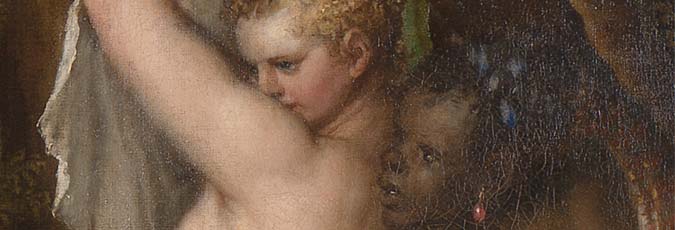Titian’s 'Diana and Actaeon'
‘Art is one of the best and safest, and most lasting pleasures which in this weary changeable world we are glad to make the substitutes for happiness. I remember that on entering the Bridgewater Gallery after a long absence, all things so changed within and without, I could almost have burst forth in the eloquent apostrophe of a fellow enthusiast – “Thou, O divine Bath of Diana, with deep azure dyes, with roseate hues spread by the hand of Titian – art still there, another, yet the same, that thou wert five and twenty years ago!'”.'1
Thus Mrs. Jameson, the prolific Victorian author of popular guides to Old Master painting, describes her joyful reunion with Titian’s Diana and Actaeon. The picture has excited high praise down the ages, from Giorgio Vasari in 16th-century Italy (who stated that Titian used ‘colours in a way that made [the figures] appear alive and natural’), to the great 19th-century art-critic William Hazlitt who called the work and its companion ‘perfect studies in the Venetian art of colouring’ and Ellis Waterhouse in the 20th century, who pronounced the painting ‘a miracle’ being ‘an incredible design in every dimension’.2
When viewed alone the 'Diana and Actaeon' is a remarkable work but arguably it has greater impact when seen with the other works with which it was intended to hang. Furthermore, one only has to scan mentally the various collections to which it has belonged during its 450 year history and recall where it was displayed to realise that this work has played a significant role in confirming and expanding the established taste for Italian Renaissance art in Britain.
'Diana and Actaeon' was painted as a pendant to another episode from the goddess Diana’s life: 'Diana and Callisto', which shows the hapless nymph Callisto, who had been seduced by Jupiter and discovered to be pregnant, being denounced to the chaste moon-goddess Diana. Closely related both visually and thematically, the National Gallery’s 'Diana and Actaeon' and the 'Diana and Callisto' were painted for no less a patron than the powerful, ambitious and art-loving King Philip II of Spain. In a letter to his royal patron, Titian noted that he had started the 'Diana and Acteon' scene in 1556, while in another missive, of 19 June 1559, he reported that the companion pictures were finished (although he went on working on them for another three months). They were dispatched from Venice in October 1559, but their arrival in Spain was not acknowledged until 2 April 1561.3
Titian’s paintings of Diana were not a ‘stand alone’ pair but rather were conceived within a larger series of mythological paintings (or ‘poesie’) drawn mainly from Ovid’s 'Metamorphoses'. It is not clear that it was a closed series; in other words Titian could have added other subjects to the seven mythologies which he did produce - piecemeal fashion. Among their number is The Death of Actaeon (now also in the National Gallery) which depicts the final act of the tragedy whose first act is played out in the 'Diana and Acteon'. This particular painting, begun in 1556 and worked on intermittently, was never completed which may explain why it did not find its way to Spain.4 By contrast, the other paintings were finished and Philip II ended up with a sumptuous grouping which included images of 'Danäe', 'Venus and Adonis', 'Perseus and Andromeda' and the 'Rape of Europa'.
Having started off life in a royal palace, a noble course seems to have been set for the pair of Diana pictures. They, together with others of Titian’s mythologies and other paintings by the artist, ended up in France where they joined what was in effect the collection of the royal house. This occurred because Philip V, unlike his earlier namesakes Philip II and IV, was not a great art lover and he gave the two 'Dianas' and the 'Europa' to the duc de Gramont in 1704, during Gramont’s time as French Ambassador at the Spanish Court. Gramont, in turn, ceded them to the notorious Philippe, duc d’Orléans.
Within the short time-span of his becoming virtual ruler of France in 1715 and his death eight years later, the duc d’Orléans built up a virtually unrivalled art-collection containing paintings, sculptures, engravings, and miniatures. His paintings included masterpieces from the Italian, French, Dutch and Flemish schools brought together from such distinguished collections as those of King Charles I of England and Cardinals Richelieu and Mazarin in France. By far the most important source was the collection of Queen Christina of Sweden, which the duc d’Orléans had purchased 'en bloc'. Among the Orléans Italian paintings, which boasted six Raphaels and six Correggios, highlights were the Titians of which there were over 20 examples,6 some exemplifying the artist’s earliest manner including the Noli me Tangere (now in the National Gallery), the 'Four Ages of Man' and 'Venus Rising from the Sea' and others, like 'Diana and Actaeon', representative of Titian’s mature or late work.
Next: English royalty and aristocracy

